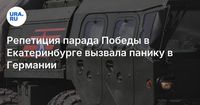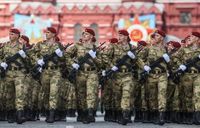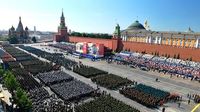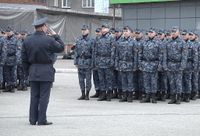As the countdown to Victory Day on May 9, 2025, begins, participants in the annual parade are gearing up with rigorous rehearsals across Russia. In Novokuznetsk, the first three training sessions took place at the Kuzbass Institute of the Federal Penitentiary Service square, where the soldiers practiced their marching routines. The rehearsals will continue with a total of 12 sessions planned to ensure the precision and coordination needed for the event, according to Alexander Shemansky, who commands the units involved.
"This training is like in sports; you miss a couple of days, and your conditioning changes entirely," Shemansky remarked, highlighting the importance of consistent practice. He noted that even first-year cadets have improved their skills by observing the more experienced participants during these sessions. The upcoming rehearsals are not just about maintaining readiness but also about instilling a sense of discipline and teamwork among the troops.
On April 30, May 5, and May 7, participants will march along Kirov Street, with the road closed to traffic during these times. This year, a notable number of newcomers will join the ranks, adding to the anticipation of the event. The preparation is not just a routine drill; it reflects a deeper commitment to honoring the sacrifices made during World War II while showcasing the evolving military capabilities of Russia.
Meanwhile, as preparations unfold, concerns are mounting in Germany regarding the upcoming parade. The German newspaper Bild reported on April 16, 2025, that the rehearsal in Yekaterinburg has drawn significant attention, particularly due to the display of modern military equipment instead of the traditional Soviet tanks. Observers noted that the Kremlin has seemingly curated an ideal combat unit that is pragmatic, effective, and lethal.
The rehearsal featured tanks equipped with anti-aircraft protection, as well as multiple launch rocket systems such as the BM-21 and BM-30. Additionally, armored personnel carriers with electronic warfare systems, bridge layers, medical vehicles, and sapper robots were showcased, signaling a shift in military strategy.
German security expert Nico Lange commented on the implications of these changes. In an interview with Bild, he stated, "The rejection of traditional parade symbols and the focus on real combat capabilities indicate serious changes in approach. This parade is no longer just a memory of the past; it is a demonstration of preparation for future challenges." Lange's insights reflect a broader unease in Germany regarding Russia's military posture and the implications it holds for European security.
The upcoming Victory Day parade is not merely a ceremonial event; it serves as a platform for Russia to project its military strength and readiness. The integration of modern technology and tactics into the parade is seen as a response to the lessons learned from recent military engagements.
As both Russia and Germany navigate this evolving landscape, the significance of the parade extends beyond national pride. It encapsulates the ongoing tensions and the strategic recalibrations that define contemporary military discourse. Observers from various nations will undoubtedly scrutinize the event, interpreting it through the lens of geopolitical dynamics.
In Novokuznetsk, the local community is also gearing up for the celebrations, with residents expressing pride in the military's preparations. The parade represents a moment of unity and remembrance, drawing attention not only to the sacrifices of the past but also to the present-day military capabilities of the nation.
As rehearsals progress, the atmosphere is charged with anticipation. The participants are not just marching; they are embodying a legacy that resonates deeply within the Russian psyche. The meticulous preparations reflect a commitment to honoring the past while preparing for an uncertain future.
With the parade just weeks away, the convergence of local pride and international scrutiny sets the stage for a significant event that will echo beyond the borders of Russia. The world will be watching as the participants take to the streets, showcasing not only their skills but also the evolving narrative of Russia's military identity.









